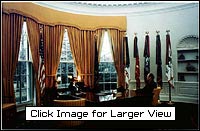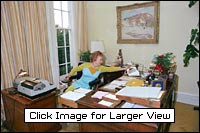|
Less than a week following Butterfield’s revelation, Nixon ordered an end to White House taping. Shortly afterward, the Senate committee, Special Prosecutor Cox, and Judge Sirica ordered relevant tapes be turned over. Nixon refused, claiming executive privilege. By August the matter was in court. Nixon addressed the nation on August 15, 1973, explaining to the people why confidential conversations between the president and his advisors should not be made a matter of public record. Lawyers for the Watergate committee and Special Prosecutor’s office argued that conversations dealing with matters of potential illegality should not be suppressed by claims of executive privilege.
On October 12, Nixon nominated Congressman Gerald Ford (R-MI) to fill the vacancy left by the resignation of Vice President Spiro Agnew following charges of bribery and tax evasion. That same day, the U. S. Circuit Court of Appeals in Washington ruled that Nixon must turn over the tapes to Judge Sirica. Knowing the implications and rather than comply, Nixon suggested a compromise, offering edited transcripts to the various investigating offices. Special Prosecutor Cox refused, and on the evening of October 20, a political bloodletting labeled the “Saturday Night Massacre” ensued. Nixon, angered by Cox’s response, ordered Attorney General Richardson to fire the prosecutor. Richardson resigned rather than obey. Immediately afterward, Nixon ordered Richardson’s assistant, William Ruckelshaus, to fire Cox. He, too, refused and resigned. Finally, Solicitor General Robert Bork was given the order and carried it out.
A hail of criticism pelted the White House, including calls for Nixon’s impeachment. In the face of this outrage, Nixon relented and agreed to surrender the subpoenaed tapes. He then appointed Texas attorney Leon Jaworski to replace Cox.
Troubling revelations followed the release of the tapes. The White House claimed that some tapes subject to the subpoena did not exist. One contained an erased gap that stretched for over eighteen minutes. Nixon’s secretary, Rose Mary Woods, and others in the White House offered conflicting accounts for what experts contended were five or more separate erasures. White House Chief of Staff Alexander Haig credited the gap to “some sinister force.” Others outside the White House concluded key evidence had been deliberately destroyed.
|
 |
| ARC #186969 |
 |
 |
 |
| Richard M. Nixon and Representative Gerald R. Ford meet in the Oval Office prior to the nomination of Mr. Ford to succeed Spiro T. Agnew as Vice President, October 13, 1973 |
 |
| #E1874-16A |
 |
 |
 |
| Rosemary Woods demonstrating how she may have erased tape recordings |
 |
|



